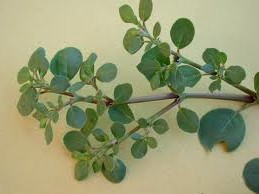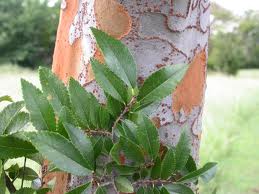What do you do when the description of a plant doesn’t fit? The answer depends on how far off the description is: You might have the wrong plant.
If it is supposed to have five-petaled yellow flowers and you have white flowers with three petals, it is probably the wrong plant. What if it is the right plant but still off a little? What you come to learn is you subconsciously put together a picture of a particular plant that takes variations into consideration once you know the plant. That picture will serve you well.
I’ve noticed a plant nearby that looks like purslane. Now I have foraged purslane and I’ve grown it. This plant is similar but it is not quite purslane and it is very tempting to make it fit. You must avoid that. The look of purslane that I have in my head lets me see similar pattens in this new plant but also told me it is not purslane. I think it might be Trianthema portulacastrum, a possible edible.
A few days ago I was keying out a different plant, that is, comparing what I had in front of me to a very exact botanical description. Everything fit except minute papillons. Papillons are tiny nipple-like structures. This plant was supposed to have them at the nodes and on the back of its sepals. Look as I may I could not find any papillons on the plant anywhere but I was reasonably sure I had the right plant and not a relative. What were the possibilities?
1) Perhaps I had the wrong plant and this minute difference was the only difference between related plants. That happens a lot. That’s how we get variations in species or a new botanical name altogether (after the discoverer of that minute difference.) 2) Another possibility was the plant the person was describing had a disease that created little papillons. 3) And yet another possibility was the describer saw papillons whether they were there or not. That, too, is not unheard of. What to do?
With most plants that is easy: Find a couple of more descriptions. I did, and neither of those mentioned papillons. I had the right plant. I was not so lucky with the Chinese Elm.
There are several Chinese Elms near here, Ulma parvifolia. Every description I have read of them on-line says they have tiny hairs on the leaf stem, or underside of the leaves. I have never seen such hair on any of them. Ever. Never. No way. Yet they are Chinese Elms and quite edible. What to do?
First it was rather a moot point since I was already consuming the tree. But more to the point, it is also in a family of no known toxicity so these missing little hairs were a mystery — still are a mystery — but not a party spoiler. These particular trees have been cultivated for centuries and there are many varieties and the ones near me, all planted at the same time long ago, maybe of a hairless variety. More so, this is a common landscape plant so there are a lot of them around and none of them that I can see have such tiny hairs. Maybe I need a microscope. At any rate, they certainly taste good, and I’m still here to relate the mystery.




Have you ever tried the universal edibility test? If so, how did it work for you (were the results that the plant was or was not edible?)
I have written about it extensively. I have tried it, and, I think it is a very bad idea. I have turned down large fees to teach it.
https://www.eattheweeds.com/field-testing-plants-for-edibility/
Yes, I agree that the universal edibility test is a bad idea and would not try it unless I was sure death by starvation was certain (at my present weight I could probably go 20 to 30 days without food depending on how many calories being burned per day). That is why I am taking the time to learn how to forage and I greatly appreciate your wealth of knowledge. Besides, foraging can be something for the shear joy of people who like to eat (like me).
Oh, have you ever considered putting your information together to create a correspondence course? I think a lot of people would pay to learn what you know.